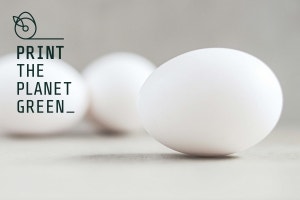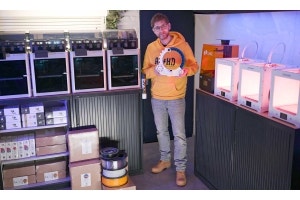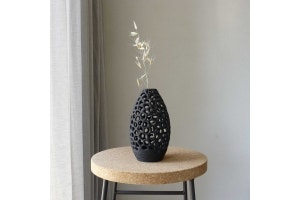
How to Print with LW-ASA Filament: A Complete Guide for Lightweight and Durable 3D Printing
ColorFabb LW-ASA (Lightweight Acrylonitrile Styrene Acrylate) filament is a unique material designed to produce lightweight, durable, and weather-resistant 3D prints. It combines the strength and UV resistance of traditional ASA with foaming technology to reduce weight, making it perfect for outdoor applications and projects where lightweight properties are essential. The filament foams during printing, allowing you to adjust the density and achieve substantial weight savings without compromising durability.
In this guide, we’ll walk you through everything you need to know about printing with LW-ASA filament—from printer setup and optimal settings to troubleshooting tips and best practices. Whether you’re making parts for drones, automotive components, or outdoor equipment, LW-ASA’s unique properties make it a versatile choice for robust, lightweight, and long-lasting 3D prints.
What is LW-ASA Filament?
Key Properties of LW-ASA
LW-ASA by ColorFabb is a foaming filament that expands when heated, allowing users to control the material’s density and weight during printing. This foaming behavior, combined with ASA’s natural UV resistance and strength, makes LW-ASA an ideal choice for outdoor parts, structural components, and applications requiring both durability and lightness.
Key properties of LW-ASA include:
- Lightweight Foaming Technology: LW-ASA expands during printing, reducing material usage and overall weight. This feature is highly useful for applications where minimizing weight is critical, like drones or RC planes.
- UV and Weather Resistance: ASA is naturally resistant to UV light and harsh weather, making LW-ASA an excellent choice for outdoor projects.
- Excellent Strength and Durability: LW-ASA provides a high level of mechanical strength, similar to ABS, without the warping issues.
- High Heat Resistance: Like standard ASA, LW-ASA has good heat resistance, which helps maintain dimensional stability in hot environments.
Benefits of Using LW-ASA Filament
- Lightweight Parts: The foaming capability allows for lightweight parts without compromising strength, ideal for drones, RC models, and automotive components.
- UV and Weather Resistance: LW-ASA’s natural UV resistance makes it a reliable choice for outdoor applications that require long-lasting durability.
- Excellent Strength-to-Weight Ratio: LW-ASA combines the mechanical strength of ASA with reduced weight, providing an outstanding strength-to-weight ratio.
- Good Layer Adhesion and Dimensional Stability: LW-ASA minimizes warping, producing high-quality prints even with large models.
Ideal Applications for LW-ASA
Thanks to its lightweight, weather-resistant, and durable properties, LW-ASA is ideal for various functional applications, including:
- Drones and RC Models: Perfect for lightweight and structurally strong parts that reduce the load on motors and improve efficiency.
- Outdoor Equipment and Components: Suitable for garden tools, brackets, and enclosures that need UV and weather resistance.
- Automotive Parts: Lightweight, durable parts that can withstand exposure to sunlight and varying temperatures.
- Architectural Models: Creates sturdy, lightweight models that retain structural integrity even in outdoor environments.
How to Print with LW-ASA Filament
Printing with LW-ASA requires specific settings to take full advantage of its foaming capabilities and to achieve the best quality and durability. Below, we’ll outline the recommended printer setup, temperature settings, and other tips to help you get the most out of this filament.
1. Recommended Printer Setup
All-Metal Hotend
Due to the high temperatures required for LW-ASA, an all-metal hotend is recommended. LW-ASA generally prints at temperatures between 240°C and 260°C, which can cause wear on PTFE-lined hotends over time. Using an all-metal hotend will ensure consistent performance and durability when printing with high-temperature materials like LW-ASA.
Heated Bed
A heated bed is essential for LW-ASA to prevent warping, especially for larger prints. Set the bed temperature between 80°C and 100°C for optimal adhesion and to help reduce warping. A heated bed improves first-layer adhesion and stabilizes the print base.
Enclosure (Recommended for Large Parts)
For large prints, using an enclosure can help maintain a stable temperature around the print, which reduces the risk of warping or cracking. While LW-ASA is less prone to warping than standard ABS, an enclosed printer can still be beneficial in colder environments.
2. Optimal Temperature Settings
Extruder Temperature
The recommended extruder temperature range for LW-ASA is 240°C to 260°C. Start around 250°C and adjust based on your printer’s behavior. Higher temperatures can increase foaming, making prints lighter, while lower temperatures reduce foaming for denser prints. Experiment to find the best balance between strength and weight.
Bed Temperature
Set the heated bed to 80°C - 100°C for the best results. This temperature range helps to ensure that the first layer adheres properly and reduces warping, especially for large or flat parts.
3. Print Speed and Retraction Settings
Print Speed
LW-ASA should be printed at moderate speeds to control foaming and improve surface finish. A speed of 30-50 mm/s is recommended, with slower speeds yielding better control over the foaming process. Lower print speeds can also improve layer adhesion and surface quality.
Retraction Settings
Use minimal retraction with LW-ASA to avoid filament jams caused by the expansion properties of the material. Set the retraction distance to 1-2 mm and the retraction speed to 20-30 mm/s. Excessive retraction can lead to inconsistent extrusion due to the foaming behavior, so keep retraction to a minimum.
4. Layer Height and Extrusion Settings
Layer Height
For LW-ASA, a layer height of 0.2 mm provides a good balance between detail and print speed. You can go down to 0.1 mm for more detailed prints or up to 0.3 mm for faster, thicker prints where fine details aren’t critical.
Extrusion Multiplier (Flow Rate)
Because LW-ASA expands, you may need to adjust the extrusion multiplier to achieve the desired density and weight. Start with 100% flow rate and experiment by lowering it to control the foaming. For lightweight prints, reduce the flow rate gradually and observe the results.
Understanding and Controlling the Foaming Process
One of the most unique features of LW-ASA is its ability to foam, allowing you to adjust the density of your prints. Here’s how to take advantage of this feature:
-
Temperature Control: Higher extruder temperatures increase the foaming effect, resulting in lighter parts. For example, printing at 260°C will produce more foaming than printing at 240°C. By fine-tuning the temperature, you can control the weight and density of your print.
-
Extrusion Multiplier: Reducing the flow rate can also control the foaming. When set to lower flow rates, LW-ASA expands more, using less material while maintaining volume.
-
Layer Height and Wall Thickness: Use thicker layers and walls if you need a more solid structure, while thinner layers and lower flow rates result in a lighter, more porous print.
Troubleshooting Common Issues with LW-ASA
Issue: Warping and Poor Bed Adhesion
Solution: Ensure the bed is heated to 80°C - 100°C, and consider using an adhesive like glue stick or Kapton tape to improve adhesion. For large prints, using an enclosure can also help maintain a stable temperature, reducing warping.
Issue: Inconsistent Extrusion
Solution: Inconsistent extrusion can result from the foaming process. Make sure to adjust the flow rate and extrusion temperature carefully. If extrusion is still inconsistent, try reducing the retraction distance to minimize interruptions in the filament path.
Issue: Over-Foaming
Solution: If the print is too light or appears overly porous, lower the extrusion temperature or increase the flow rate. Experiment with reducing the print temperature in 5°C increments to control the foaming effect better.
Issue: Stringing and Oozing
Solution: Reduce the print temperature slightly and minimize retraction settings. Lowering the temperature and print speed can also help reduce oozing and stringing.
Tips for Achieving the Best Results with LW-ASA
- Experiment with Temperature for Desired Density: LW-ASA’s foaming properties allow you to control the density by adjusting the temperature. Lower temperatures yield denser prints, while higher temperatures make them lighter.
- Use a Heated Bed and Enclosure for Larger Prints: A heated bed at 80°C - 100°C helps with bed adhesion and minimizes warping. For larger parts, enclosing the printer stabilizes the environment and improves print quality.
- Minimize Retraction: Due to LW-ASA’s foaming properties, excessive retraction can cause issues. Use minimal retraction to avoid filament jams and inconsistent extrusion.
- Adjust Layer Height and Wall Thickness: Thicker walls and layers produce sturdier prints, while thinner settings help reduce weight. Experiment to find the best balance for your application.
Recommended Slicer Settings for LW-ASA
For slicers like Cura, PrusaSlicer, or Simplify3D, start with these recommended settings and adjust as needed based on your specific printer:
- Extruder Temperature: 240°C - 260°C
- Bed Temperature: 80°C - 100°C
- Print Speed: 30 - 50 mm/s
- Layer Height: 0.2 mm (adjust for desired detail)
- Retraction Distance: 1 - 2 mm
- Retraction Speed: 20 - 30 mm/s
- Cooling Fan: Off or minimal, as ASA materials benefit from minimal cooling
ColorFabb LW-ASA is an innovative filament that combines lightweight foaming properties with the strength and UV resistance of ASA, making it an excellent choice for outdoor, durable applications. By following these settings and techniques, you’ll be able to produce high-quality, lightweight, and weather-resistant prints that are ideal for drones, RC models, automotive parts, and other functional designs. With the right adjustments, LW-ASA enables you to achieve an optimal balance between strength and weight, opening up new possibilities for 3D printing applications.










